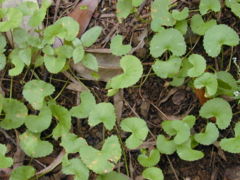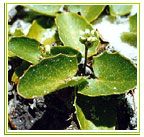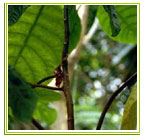

|

Centella Asiatica
Family Name : APIACEAE
Botanical Name : CENTELLA
ASIATICA
Common Name : PENNYWORT,
INDIAN PENNYWORT, ARTAYNIYA-E HINDI, JAL BRAHMI
Part Used : WHOLE PLANT
Habitat : Grown in waterlogged
places throughout India.
 Uses : : It is Tonic, Diuretic
and Alterative. It is used in treatment of leporasy and known to ameliorate
the symptoms of the disease and improves general health of the patient.
It is a brain tonic and stimulates hair growth.
Uses : : It is Tonic, Diuretic
and Alterative. It is used in treatment of leporasy and known to ameliorate
the symptoms of the disease and improves general health of the patient.
It is a brain tonic and stimulates hair growth.
Centella asiatica is a small
herbaceous annual plant of the family Apiaceae, native to Asia. Common
names include Gotu Kola, Asiatic Pennywort, Antanan, Pegaga, and Brahmi
(although this last name is shared with Bacopa monnieri and other herbs).
It is used as a medicinal herb in Ayurvedic medicine and traditional Chinese
medicine.
The stems are slender, creeping
stolons, green to reddish green in color, interconnecting one plant to
another. It has long-stalked, green, reniform leaves with rounded apices
which have smooth texture with palmately netted veins. The leaves are born
on pericladial petioles, around 20 cm. The rootstock consists of rhizomes,
growing vertically down. They are creamish in color and covered with root
hairs.
The flowers are pinkish to
red in color, born in small, rounded bunches (umbels) near the surface
of the soil. Each flower is partly enclosed in two green bracts. The hermaphrodite
flowers are minute in size (less than 3 mm), with 5-6 corolla lobes per
flower. Each flower bears five stamens and two styles.
The crop matures in three
months and the whole plant, including the roots, is harvested manually.
When eaten raw as a salad leaf, pegaga is thought to help maintain youthfulness.
A decoction of juice from the leaves is thought to relieve hypertension.
This juice is also used as a general tonic for good health. A poultice
of the leaves is also used to treat open sores. Interestingly, chewing
on the plant for several hours induces entheogenic meditation, similar
to the effects of salvia divinorum, although this practice is widely considered
dangerous, as it can cause temporomandibular joint pains.
.
Cinchona Officinalis
Family Name : RUBIACEAE
Botanical Name : CINCHONA
OFFICINALIS
Common Name : QUININE, PERUVIAN
BARK, QUININE BARK
Part Used : QUININE ISOLATED
FROM BARK
Habitat : Cultivated in Nilgiri
Hills
Uses : Quinine is bitter,
astringent, acrid, thermogenic, febrifugre, oxytoxic and anodyne. It is
digestive, antipyretic, cardiotonic, dystocia, eumbago etc
|
|















